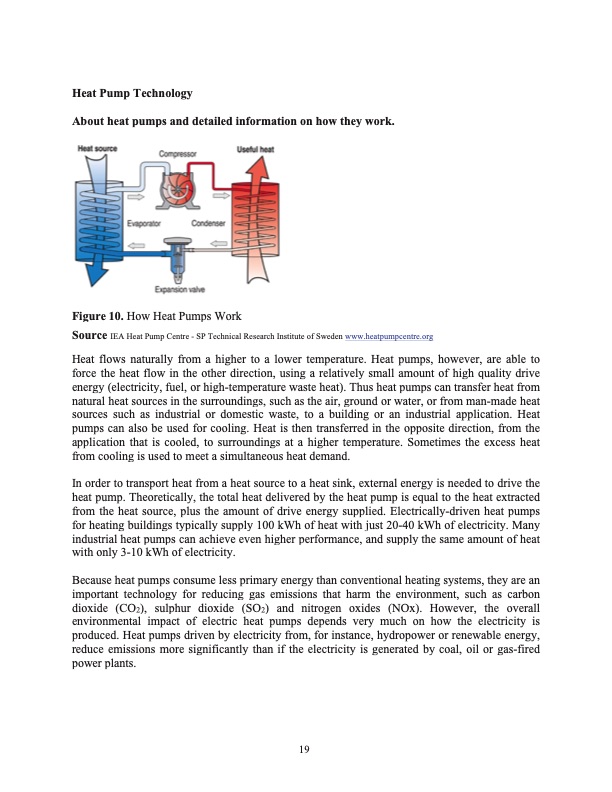
PDF Publication Title:
Text from PDF Page: 019
Heat Pump Technology About heat pumps and detailed information on how they work. Figure 10. How Heat Pumps Work Source IEA Heat Pump Centre - SP Technical Research Institute of Sweden www.heatpumpcentre.org Heat flows naturally from a higher to a lower temperature. Heat pumps, however, are able to force the heat flow in the other direction, using a relatively small amount of high quality drive energy (electricity, fuel, or high-temperature waste heat). Thus heat pumps can transfer heat from natural heat sources in the surroundings, such as the air, ground or water, or from man-made heat sources such as industrial or domestic waste, to a building or an industrial application. Heat pumps can also be used for cooling. Heat is then transferred in the opposite direction, from the application that is cooled, to surroundings at a higher temperature. Sometimes the excess heat from cooling is used to meet a simultaneous heat demand. In order to transport heat from a heat source to a heat sink, external energy is needed to drive the heat pump. Theoretically, the total heat delivered by the heat pump is equal to the heat extracted from the heat source, plus the amount of drive energy supplied. Electrically-driven heat pumps for heating buildings typically supply 100 kWh of heat with just 20-40 kWh of electricity. Many industrial heat pumps can achieve even higher performance, and supply the same amount of heat with only 3-10 kWh of electricity. Because heat pumps consume less primary energy than conventional heating systems, they are an important technology for reducing gas emissions that harm the environment, such as carbon dioxide (CO2), sulphur dioxide (SO2) and nitrogen oxides (NOx). However, the overall environmental impact of electric heat pumps depends very much on how the electricity is produced. Heat pumps driven by electricity from, for instance, hydropower or renewable energy, reduce emissions more significantly than if the electricity is generated by coal, oil or gas-fired power plants. 19PDF Image | Heat Pump Technology

PDF Search Title:
Heat Pump TechnologyOriginal File Name Searched:
jcos_heat_pump_technology.pdfDIY PDF Search: Google It | Yahoo | Bing
CO2 Organic Rankine Cycle Experimenter Platform The supercritical CO2 phase change system is both a heat pump and organic rankine cycle which can be used for those purposes and as a supercritical extractor for advanced subcritical and supercritical extraction technology. Uses include producing nanoparticles, precious metal CO2 extraction, lithium battery recycling, and other applications... More Info
Heat Pumps CO2 ORC Heat Pump System Platform More Info
| CONTACT TEL: 608-238-6001 Email: greg@infinityturbine.com | RSS | AMP |